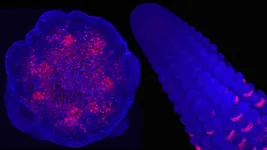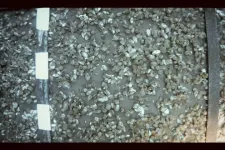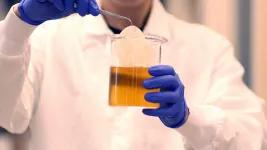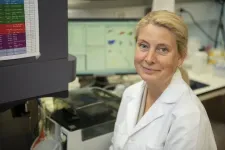Building a corn cob--cell by cell, gene by gene
2021-01-26
(Press-News.org) Corn hasn't always been the sweet, juicy delight that we know today. And, without adapting to a rapidly changing climate, it is at risk of losing its place as a food staple. Putting together a plant is a genetic puzzle, with hundreds of genes working together as it grows. Cold Spring Harbor Laboratory (CSHL) Professor David Jackson worked with Associate Professor Jesse Gillis to study genes involved in corn development. Their teams analyzed thousands of individual cells that make up the developing corn ear. They created the first anatomical map that shows where and when important genes turn on and off during key steps in development. This map is an important tool for growing better crops.
Humans have been breeding corn to make it more useful for thousands of years. Jackson says:
"Ten thousand years ago, corn did not exist, right? There was a wild plant called teosinte. Teosinte itself only makes about 10 seeds. It makes these really tiny ears that don't give much nutrition. In fact, the seeds they make are so tough that they would break your teeth if you try to eat them anyway."
The secret to more and bigger kernels is found by looking at baby ears of corn 1-10 mm long. The scientists used a technique that allowed them to track every cell. They gave each cell a genetic ID tag, called a barcode. Xiaosa Xu, the lead author of the study, compares it to building a building. Xu says:
"We are able to use this single-cell RNA-seq technology to identify which block is what kind of identity: if this block is from our kitchen room or that block is from our bedroom."
The scientists took corn plants at early stages of development, broke them into individual cells, barcoded them, and then saw what genes were turned on in each one. Jackson notes, "in the past we haven't been able to separate the cells and figure out the genetic information that's specific to each cell. So that's really, what's new and exciting." They could then reconstruct an anatomical map to pinpoint where genes important for corn development were used.
Crops are still evolving. Jackson looks forward to developing different kinds of corn plants to fill new ecological niches. He also hopes this new technique will help other plant geneticists in their efforts to sustainably improve crop yields.
INFORMATION:
[Attachments] See images for this press release:

ELSE PRESS RELEASES FROM THIS DATE:
2021-01-26
Pneumonia and the flu kill tens of thousands of Americans each year, racking up billions of dollars in medical costs and even more in lost productivity.
But new research from the University of Georgia shows that state laws promoting flu vaccinations for hospital workers can substantially reduce the number of influenza-related deaths.
Spanning 23 years, the study looked at the mortality rate from influenza and pneumonia during peak flu season (from December through March of each year), comparing changes in mortality over time in the 13 states and Washington, D.C., that adopted laws to the changes in mortality in states without laws. ...
2021-01-26
The health of aquatic ecosystems depends on the supply of key nutrients, especially phosphorus. Too much phosphorus results in unwanted eutrophication, and much effort is spent on preventing phosphorus pollution of water bodies. In the World's largest freshwater ecosystem, the North American Great Lakes, this control may have recently been lost to an invasive species. According to a new study, quagga mussels, which have spread across four of the five Great Lakes, have accumulated large amounts of phosphorus in their biomass, to the degree that their activities now regulate the supply of phosphorus ...
2021-01-26
Their field may not be top of mind among those that contribute to the greater good, yet new research from the University of Notre Dame shows marketers can help entrepreneurs in emerging markets grow their businesses, which in turn helps them to improve lives, sustain livelihoods, enhance overall living standards and strengthen societies.
"Do Marketers Matter for Entrepreneurs? Evidence from a Field Experiment in Uganda" is forthcoming in the Journal of Marketing from Frank Germann, an associate professor of marketing at Notre Dame's Mendoza College of Business who teaches ...
2021-01-26
Cell phone data that is routinely collected by telecommunications providers can reveal changes of behavior in people who are diagnosed with a flu-like illness, while also protecting their anonymity, a new study finds. The Proceedings of the National Academy of Sciences (PNAS) published the research, led by computer scientists at Emory University and based on data drawn from a 2009 outbreak of H1N1 flu in Iceland.
"To our knowledge, our project is the first major, rigorous study to individually link passively-collected cell phone metadata with actual public health data," says Ymir Vigfusson, assistant professor in Emory University's Department of Computer Science and a first author of the study. "We've shown ...
2021-01-26
WASHINGTON -- A multi-institutional group of researchers has developed new metamaterial tiles that will help improve the sensitivity of telescopes being built at the preeminent Simons Observatory in Chile. The tiles have been incorporated into receivers that will be deployed at the observatory by 2022.
The Simons Observatory is the center of an ambitious effort to measure the cosmic microwave background -- electromagnetic radiation left over from an early stage of the universe -- using some of the world's largest and most sophisticated ground-based telescopes. ...
2021-01-26
Providing economic relief to struggling families can lead to another positive effect -- fewer cases of child neglect, according to new research by the University of Washington.
A 10% increase in a common benefit for low- to moderate-income working families, the Earned Income Tax Credit, led to a 9% decrease in the annual number of reports of child neglect made to child welfare agencies over a 14-year study period. That's a significant impact, researchers say, and can inform future social policies.
The study is relevant to current policy actions, as President Joe Biden has recently proposed an expansion ...
2021-01-26
RESEARCH TRIANGLE PARK, N.C. -- Kombucha tea, a trendy fermented beverage, inspired researchers to develop a new way to generate tough, functional materials using a mixture of bacteria and yeast similar to the kombucha mother used to ferment tea.
With Army funding, using this mixture, also called a SCOBY, or symbiotic culture of bacteria and yeast, engineers at MIT and Imperial College London produced cellulose embedded with enzymes that can perform a variety of functions, such as sensing environmental pollutants and self-healing materials.
The team also showed that they could incorporate yeast directly into the cellulose, creating living materials that could be used to purify water for Soldiers in the field or make smart packaging materials that can detect damage.
"This ...
2021-01-26
COLUMBIA, Mo. - In 2016, the World Health Organization called the Zika virus epidemic a "public health emergency of international concern" due to the virus causing birth defects for pregnant women in addition to neurological problems. Since then, researchers have wrestled with different strategies for controlling the spread of Zika virus, which gets transmitted to humans from female mosquito bites.
One approach, which was approved by the Environmental Protection Agency in May, will release more than 750 million genetically modified mosquitos into the Florida Keys in 2021 and 2022. These "suicide mosquitos" are genetically-altered to produce offspring that die before emerging into adults and therefore cannot ...
2021-01-26
An international research collaboration, involving scientists from the UK, US and Spain, has shed new light on the usefulness of digital contact tracing (DCT) to control the spread of Covid-19.
The study, published today in Nature Communications, assessed the effectiveness of the Spanish DCT app, Radar COVID, following a 4-week experiment conducted in the Canary Islands, Spain between June-July 2020.
For the experiment, funded by the Secretary of State of Digitalisation and Artificial Intelligence (SEDIA), the researchers simulated a series of Covid infections in the capital of La Gomera, San Sebastián de la Gomera, to understand whether the Radar COVID app technology could ...
2021-01-26
Individual variations in how the immune system responds to SARS-CoV-2 appear to impact the severity of disease. Researchers at Karolinska Institutet in Sweden have now been able to show that patients with severe COVID-19 have significantly elevated levels of a certain type of immune cells in their blood, called myeloid-derived suppressor cells. The study published in the Journal of Clinical Investigation may bring an increased understanding of how early immune responses impact disease severity.
Most individuals with COVID-19 develop mild to moderate symptoms and recover without needing hospital treatment. In severe cases, however, COVID-19 can lead to respiratory failure or even death. It is not yet known ...
LAST 30 PRESS RELEASES:
[Press-News.org] Building a corn cob--cell by cell, gene by gene




